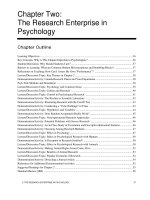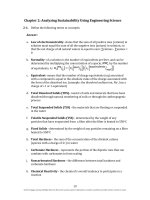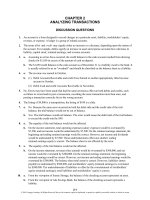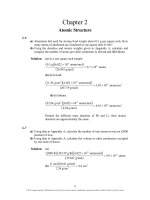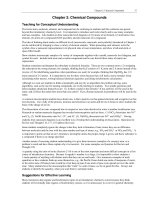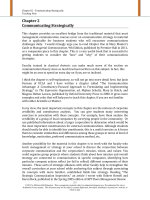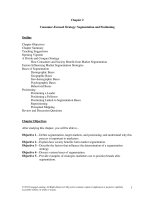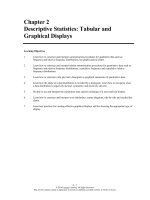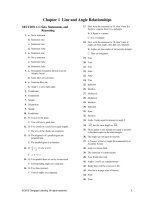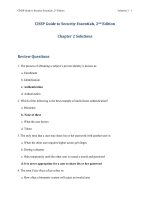Solution manual of ch02 analyzing sustainability using engineering science
Bạn đang xem bản rút gọn của tài liệu. Xem và tải ngay bản đầy đủ của tài liệu tại đây (1.91 MB, 48 trang )
Chapter 2: Analyzing Sustainability Using Engineering Science
2-1. Define the following terms or concepts:
Answer:
a. Law of electroneutrality- states that the sum of all positive ions (cations) in
solution must equal the sum of all the negative ions (anions) in solution, so
that the net charge of all natural waters is equal to zero: ∑cations - ∑anions =
0
b. Normality- of a solution is the number of equivalents per liter, and can be
determined by multiplying the concentration of a specie,
, by the number
of equivalents,
c. Equivalent- means that the number of charge equivalents (eq) associated
with a compound is equal to the absolute value of the charge associated with
the form of the dissolved ion. (example: the dissolved sodium ion, Na+, has a
charge of +1 or 1 equivalent)
d. Total Dissolved Solids (TDS)- consist of salts and minerals that have been
dissolved through natural weathering of soils or through the anthropogenic
process
e. Total Suspended Solids (TSS) - the materials that are floating or suspended
in the water
f. Volatile Suspended Solids (VSS) - determined by the weight of any
particles that have evaporated from a filter after the filter is heated to 550oC
g. Fixed Solids - determined by the weight of any particles remaining on a filter
heated to 550oC
h. Total Hardness - the sum of the concentration of the divalent cations
(species with a charge of 2+) in water
i.
Carbonate Hardness - represents the portion of the diprotic ions that can
combine with carbonates to form scaling
j.
Noncarbonated Hardness - the difference between total hardness and
carbonate hardness
k. Chemical Reactivity - the chemical’s overall tendency to participate in a
reaction
19
© 2016 Cengage Learning. All Rights Reserved. May not be scanned, copied or duplicated, or posted to a publicly accessible website, in whole or in part.
Chapter 2: Analyzing Sustainability Using Engineering Science
l.
Chemical Activity - a standardized measure of chemical reactivity within a
defined system
m. Standard State Activity - Reference state of chemical reactivity
n. Activity Coefficient - used to relate the standard chemical activity and the
conditional chemical reactivity
o. Solubility - the amount of a substance that can be dissolved into solution by
a solvent
p. Precipitate – The resulting solid form of a substance that forms from
oversaturated concentrations in solution
q. Reduction–Oxidation Process - occur when the oxidation state of
participating atoms change
r. Ionic Reaction - there is a change in ion–ion interactions and relationships
s. Dissolution Salts - the process of a substance dissolving in solution
t. Sorbent - the material into or onto which the sorbate is transferred
u. Sorbate - the substance that is transferred from one phase to another
2-2. Mass and energy balances are helpful to track chemicals as they move from
one repository to another, however, we must study the application as and
principles of chemistry more closely to appreciate how these chemicals are
transformed in the environment and also transform the earth’s environment.
2-3. How much have carbon dioxide levels in the atmosphere have increased
since the start of the industrial revolution?
Answer:
Carbon dioxide levels have increased by more than 30% since the industrial
revolution.
2-4. What 5 elements are found in life on the planet?
Answer:
Carbon
Nitrogen
Oxygen
20
© 2016 Cengage Learning. All Rights Reserved. May not be scanned, copied or duplicated, or posted to a publicly accessible website, in whole or in part.
Chapter 2: Analyzing Sustainability Using Engineering Science
Phosphorus
Hydrogen
2-5. Write the balanced equation for the combustion of methane (CH4), in the
presence of oxygen.
Answer:
CH4 + 2O2 → CO2 + 2H2O
2-6. How many atoms are in a mole?
Answer
1 mole = 6.02 x 1023 atoms
2-7. What is the numerical value of R in [J/mol-K] in the ideal gas law?
Answer:
R = 8.314 [J/mol-K]
2-8. Define the Partial Pressure of a gas.
Answer:
Partial Pressure is the pressure of each part of a gas that it exerts upon its
surroundings.
2-9. What is the relationship between the concentration of a gas in air in mg/m3
and ppmv at standard temperature and pressure?
Answer:
=
2-10. What is the relationship between the concentration of a gas in air in mg/m3
and ppmv at non-standard temperature and pressure?
Answer:
21
© 2016 Cengage Learning. All Rights Reserved. May not be scanned, copied or duplicated, or posted to a publicly accessible website, in whole or in part.
Chapter 2: Analyzing Sustainability Using Engineering Science
2-11. Relate Parts Per Billion (ppbv) to ppmv.
Answer:
1 ppmv = 1000 ppbv
2-12. Describe using chemical equations the forms of dissolved carbon dioxide in
aqueous solution.
Answer:
CO2 (g) + H2O ↔ H2CO3
[H2CO3] = [CO2 (g)] + [H2CO3] + [HCO3-] + [CO32-]
2-13. The Normality of a solution is the number of equivalents per liter, and can be
determined by multiplying the concentration of a specie, MWi, by the number of
equivalents, zi.
Answer:
2-14. The concept of an equivalent weight, EW, may also be useful in calculations
involving aqueous solutions. The Equivalent Weight of any specie, EWi, is equal
to the molar mass divided by the number of equivalents associated with the
dissolved ion.
Answer:
2-15. The ionic strength, I, of a solution is the estimate of the overall concentration
of dissolved ions in solution is defined by what?
Answer:
I = ionic strength [mol/L]
Ci = concentration of each individual ion [mol/L]
22
© 2016 Cengage Learning. All Rights Reserved. May not be scanned, copied or duplicated, or posted to a publicly accessible website, in whole or in part.
Chapter 2: Analyzing Sustainability Using Engineering Science
Zi = charge associated with each ion specie,
2-16. The activity coefficient is defined as the ratio of the reactivity per molecule of
mol of A in a real system compared to the reactivity of A in the standard
reference state.
Answer:
γA
2-17. The fundamental parameter for equilibrium base models is the equilibrium
constant, k.
A+B⟷C+D
k equilibrium =
2-18. The pH of natural waters is important to biodiversity since most species are
only tolerant of natural waters in the pH range from 6.5 to 8.5.
2-19. Phosphoric acid has the form H3PO4. List all the acids that may donate a
hydrogen ion and the conjugate bases that may accept the proton for this acid
compound.
Answer:
The acid that donates the hydrogen ion and the base that accepts the ion are
collectively known as an acid conjugate base pair, as shown below:
Acid ⟶ proton + Conjugate base pair
HA ⟶ H+ + AOR
Base + proton ⟶ Conjugate acid pair
A- + H+ ⟶ HA
2-20. What is the primary characteristic of an amphoteric compound?
Answer:
It has substances that can either donate or receive a proton.
23
© 2016 Cengage Learning. All Rights Reserved. May not be scanned, copied or duplicated, or posted to a publicly accessible website, in whole or in part.
Chapter 2: Analyzing Sustainability Using Engineering Science
2-21. Define the equilibrium constant for pure water.
Answer:
H2O ⟶ H+ + OHKw =
2-22. What are the primary characteristics of a strong acid?
Answer:
Strong acids completely dissociates when added to water
Ex. HA ⟶ H+ + A- and {HA} ≈ 0
2-23. What are the primary characteristics of a strong base?
Answer:
Strong bases may be assumed to completely dissociate with a large value of kb.
Ex. BOH ⟶ B+ + OH- and {BOH} ≈ 0
2-24. Write the equation that defines pH.
Answer:
pH = -log{H+}
2-25. Write the equation that defines pOH.
Answer:
pOH = -log{OH-}
2-26. Write the equation that relates kw, pH, and pH.
Answer:
Kw = {H+}{OH-} = 10-14
2-27. What are the steps involved in modeling the effects of acids or bases in the
natural environment?
24
© 2016 Cengage Learning. All Rights Reserved. May not be scanned, copied or duplicated, or posted to a publicly accessible website, in whole or in part.
Chapter 2: Analyzing Sustainability Using Engineering Science
Answer:
Step 1: Define the system boundaries.
Step 2: Identify all the chemical species of interest.
Step 3: Write the constraining chemical equations for the system,
including equilibrium equations, the electroneutrality equation and
mass balance equations.
Step 4: Make any simplifying assumptions that are possible.
Step 5: Algebraically solve the remaining independent equations and
check the assumptions made to aid in solving the equations.
2-28. Define the primary characteristic of a weak acid that only partially
dissociates in an aqueous solution is called a weak acid.
Answer:
Weak acids have small equilibrium constant (ka) values.
2-29. Define the primary characteristic of a weak acid that only partially
dissociates in an aqueous solution is called a weak base.
Answer:
Weak bases have small equilibrium constant (kb) values.
2-30. The solubility-product constant, or solid-liquid equilibrium constant, is
defined by what general reaction?
Answer:
AɑBb(s) ⟵water⟶ ɑAb+ + bBɑksp =
=
2-31. What is the fraction of the total amount of A at equilibrium in the generic xphase?
Answer:
25
© 2016 Cengage Learning. All Rights Reserved. May not be scanned, copied or duplicated, or posted to a publicly accessible website, in whole or in part.
Chapter 2: Analyzing Sustainability Using Engineering Science
2-32. The Freundlich isotherm is used to estimate the portioning of pollutants
from a more mobile phase in gas or water to the solid activated carbon material.
The Freundlich equation has what form?
Answer:
q = mass of sorbate sorbed per unit mass of sorbent (mg/g)
K = the Freundlich parameter that describes the partitioning
C = the equilibrium sorbate concentration in the aqueous solution (mg/L)
n = Freundlich isotherm intensity parameter (unitless)
2-33. The octonol/water partition coefficient, Kow, is defined by ________
Answer:
2-34. The organic carbon normalized partition coefficient is defined as_________
Answer:
2-35. A 12 ounce can of soda contains about 40 grams of sugar. What is the
concentration of sugar in a can of soda in mg/L?
Answer:
40g sugar 1oz 1000mg 1000mL
mg
111,000
12oz soda 30mL
g
L
L
26
© 2016 Cengage Learning. All Rights Reserved. May not be scanned, copied or duplicated, or posted to a publicly accessible website, in whole or in part.
Chapter 2: Analyzing Sustainability Using Engineering Science
2-36. A 2 ounce shot of espresso serving contains 100 mg of caffeine. Professor
Coffy often has a 16 ounce iced latte with 3 shots of espresso latte before his 8
am class.
a. What is the concentration of caffeine in mg/L in a single shot of espresso?
Answer:
1670
mg 1 ppmm
1670 ppmm
L 1mg
L( aq)
b. What is the concentration of caffeine in ppm in a single shot of espresso?
Answer:
3 100mg 1oz 1000mL
mg
625
625 ppmm
16oz
30mL
L
L
c. What is the concentration of caffeine in his coffee drink?
Answer:
100mg 1oz 1000mL
mg
1670
2oz
30mL
L
L
2-37. There is about 5 mg of caffeine in each shot of decaf espresso. The barista is
being paid under the table by Mrs. Coffy to change the espresso shots to
decaffeinated espresso in Professor Coffy’s 16 ounce latte drink cup from
problem 2.36.
a. How much caffeine in mg/L does Dr. Coffy consume if he drinks
decaffeinated lattes before class?
Answer:
5 3mg 1oz 1000mL
mg
31.25
16oz
30mL
L
L
b. How many 16 oz decaf lattes must he drink before he consumes the amount
of caffeine equivalent to his old 3 shots of caffeinated espresso (from 2.35)?
27
© 2016 Cengage Learning. All Rights Reserved. May not be scanned, copied or duplicated, or posted to a publicly accessible website, in whole or in part.
Chapter 2: Analyzing Sustainability Using Engineering Science
Answer:
625 mg
L 20 decaf drinks 1 caf latte
31.25 mg
L
2-38. The average concentration of dissolved oxygen (DO) in the Shenandoah River
was reported as 9.7 ppmm in 2006. What is the concentration in mg/L in the
river water?
Answer:
9.7 ppmm
1 mg
L 9.7 mg DO
1 ppmm
L
2-39. Table 2.18 includes typical constituents in water in mg/L. Complete the table
by converting the concentrations to units given in the table, and find the mass in
1000 liters of water – the amount of water you would typically ingest over the
course of a year.
Table 2.18: Typical constituents in water. Source: Tchobanoglous, G., Asano, T.,
Burton, F., Leverenz, H., Tsuchihashi, R. 2007. Water Reuse: Issues, Technologies,
and Applications. McGraw-Hill. 1570 p. ISBN-13:978-0071459273.
Answer:
Constituent
mg/L
ppm
Bicarbonate (HCO3)
Carbonate (CO3)
Chloride (Cl)
Sulfate (SO3)
Calcium (Ca)
Magnesium (Mg)
Potassium (K)
Sodium (Na)
Aluminum (Al)
Fluoride (F)
75
5
35
27
11
7
11
55
0.2
0.3
75
5
35
27
11
7
11
55
0.2
0.3
Molecular
weight
61
60
35.45
80.06
40.08
24.305
39.0983
22.9898
26.9815
18.9984
mmol/L
Kg/year
1.23
0.08
0.99
0.34
0.27
0.29
0.28
2.39
0.007
0.016
0.075
0.005
0.035
0.027
0.011
0.007
0.011
0.055
0.0002
0.0003
2-40. The total volume of the oceans on Earth is 1.35 x 1018 m3. What are the
masses of the following elements in the Ocean in units of kg?
28
© 2016 Cengage Learning. All Rights Reserved. May not be scanned, copied or duplicated, or posted to a publicly accessible website, in whole or in part.
Chapter 2: Analyzing Sustainability Using Engineering Science
Answer:
a. Oxygen, O, for which the concentration in the seawater is 857,000 ppm
From oxygen
b. Hydrogen, H, for which the concentration in the seawater is 108,000 ppm
From oxygen
c. Sodium, Na, for which the concentration in the seawater is 10,500 ppm
From oxygen
2-41. What is the density of air in grams per cubic meter at 1 atm and 200oC?
Assume the molecular weight of air is 28.967 grams/mole.
Answer:
let
then
29
© 2016 Cengage Learning. All Rights Reserved. May not be scanned, copied or duplicated, or posted to a publicly accessible website, in whole or in part.
Chapter 2: Analyzing Sustainability Using Engineering Science
2-42. The reported value of carbon dioxide in the atmosphere in 2010 was
approximately 385 ppmv. What is the concentration of carbon dioxide in the
atmosphere in mg/m3?
Answer:
(385 ppmv)(44 g
)
mg
mol
CCO2[
]
691 mg
m ^3
m^3 24.5 ppmv g m^3
mol mg
2-43. The mass of the oceans is 1.4 x 1021 kg. The concentration of potassium, K, in
the oceans is 380 ppmm. What is the total mass of the potassium stored in the
oceans in metric tonnes?
Answer:
2-44. The mass of the Earth’s troposphere, the lower part of the atmosphere, is
approximately 4.4 x 1018 kg.
30
© 2016 Cengage Learning. All Rights Reserved. May not be scanned, copied or duplicated, or posted to a publicly accessible website, in whole or in part.
Chapter 2: Analyzing Sustainability Using Engineering Science
a. Use the ideal gas law to estimate volume of the troposphere in cubic meters
at standard state (P = 1 atm, T = 298 K, R = 0.0821 atm-L/mol-K ). Note, the
average molecular weight of air is 28.967 grams/mole.
Answer:
(P = 1 atm, T = 298 K, R = 0.0821
)
b. The average mass of water in the troposphere is 1.3 x 1013 kg. Using your
answer from above, calculate the concentration of water vapor in the
troposphere in mg/m3?
Answer:
c. Using your answer from part b, what would be the concentration of water
vapor in the troposphere in ppmv?
Answer:
31
© 2016 Cengage Learning. All Rights Reserved. May not be scanned, copied or duplicated, or posted to a publicly accessible website, in whole or in part.
Chapter 2: Analyzing Sustainability Using Engineering Science
2-45. Table 2.19 represents the National Ambient Air Quality Standards (NAAQS)
air quality standard.
Table 2.19: National Ambient Air Quality Standards (Source: USEPA)
Pollutant
Carbon Monoxide (CO)
Nitrogen Dioxide (NO2)
Ozone (O3)
Sulfur Dioxide (SO2)
Averaging
time
Level
Standard conditions
(µg/m3)
8 - hour
1 - hour
1 - hour
Annual
8 - hour
1 - hour
3 - hour
9 ppm
35 ppm
100 ppb
53 ppb
0.075 ppm
75 ppb
0.5 ppm
10,286
40,000
188,000
99,500
147
196,000
1,306
Denver in
winter
(µg/m3)
9,060
35,230
166,000
87,644
129
172,556
1,150
a. Express the standards in µg/m3 at 1 atm of pressure and 25oC
Answer:
From equation 2.20
Carbon monoxide, CO with MWco = 28 g/mol
Nitrogen Dioxide, NO2 with
Ozone, O3 with
= 46 g/mol
= 48 g/mol
32
© 2016 Cengage Learning. All Rights Reserved. May not be scanned, copied or duplicated, or posted to a publicly accessible website, in whole or in part.
Chapter 2: Analyzing Sustainability Using Engineering Science
Sulfur Dioxide, SO2 with
= 64 g/mol
b. At the elevation of Denver, the pressure is about 0.82 atm. Express the
standards in µg/m3 at that pressure and temperature of 5oC.
Answer:
Carbon monoxide, CO with MWco = 28 g/mol
Nitrogen Dioxide, NO2 with
Ozone, O3 with
Sulfur Dioxide, SO2 with
= 46 g/mol
= 48 g/mol
= 64 g/mol
33
© 2016 Cengage Learning. All Rights Reserved. May not be scanned, copied or duplicated, or posted to a publicly accessible website, in whole or in part.
Chapter 2: Analyzing Sustainability Using Engineering Science
2-46. Use Henry’s law to calculate the concentration of dissolved carbon dioxide
(or inorganic carbonates) in a raindrop during the Ordovician Epoch. The
atmospheric concentration of carbon dioxide were 2240 ppmv CO2. Assuming
pressure at sea level was 1 atm and the water temperature was 20oC.
Answer:
The partial pressure of CO2
Assume
34
© 2016 Cengage Learning. All Rights Reserved. May not be scanned, copied or duplicated, or posted to a publicly accessible website, in whole or in part.
Chapter 2: Analyzing Sustainability Using Engineering Science
Figure 2.26: Fluctuation of carbon dioxide and temperature over geological
timescales
Source: Nasif Nahle. 2007. Cycles of Global Climate Change. Biology Cabinet Journal
Online. Article no 295.
35
© 2016 Cengage Learning. All Rights Reserved. May not be scanned, copied or duplicated, or posted to a publicly accessible website, in whole or in part.
Chapter 2: Analyzing Sustainability Using Engineering Science
2-47. The data shown in Table 2.20 were collected for ozone levels in the Los
Angeles, CA air basin. Plot the data recorder below in Excel in ppm and µg/m3.
Identify the years LA was not in compliance with the NAAQS standards.
Table 2.20: Ozone concentrations reported in Los Angeles, CA (Historic Ozone Air
Quality Trends, South Coast Air Quality Management District,
/>
Year
1976
1977
1978
1979
1980
1981
1982
1983
1984
1985
1986
1987
1988
1989
1990
1991
1992
1993
Basin Maximum
1-hour
average (ppm)
0.38
0.39
0.43
0.45
0.41
0.37
0.40
0.39
0.34
0.39
0.35
0.33
0.35
0.34
0.33
0.32
0.30
0.28
Basin Maximum
8-hour
Average (ppm)
0.268
0.284
0.321
0.312
0.288
0.266
0.266
0.245
0.249
0.288
0.251
0.210
0.258
0.253
0.194
0.204
0.219
0.195
Year
1994
1995
1996
1997
1998
1999
2000
2001
2002
2003
2004
2005
2006
2007
2008
2009
2010
Basin Maximum
1-hour
average (ppm)
0.30
0.26
0.25
0.21
0.24
0.17
0.184
0.190
0.167
0.216
0.163
0.182
0.175
0.171
0.176
0.176
0.143
Basin Maximum
8-hour
Average (ppm)
0.209
0.204
0.175
0.165
0.206
0.143
0.159
0.146
0.148
0.200
0.148
0.145
0.142
0.137
0.131
0.128
0.123
Answer:
Ground Level Ozone Concenta ons in Los Angeles CA
0.5
1.000
1-hr Max Ave [ppm]
0.45
0.900
8-hr Max Ave [ppm]
1-hr Max Ave [ug/m3]
Concetra on in ppm
0.4
0.800
8-hr Max Ave [ug/m3]
0.35
0.700
0.3
0.600
0.25
0.500
0.2
0.400
0.15
0.300
0.1
0.200
0.05
0.100
0
1970
1975
1980
1985
1990
1995
2000
2005
2010
0.000
2015
Year
36
© 2016 Cengage Learning. All Rights Reserved. May not be scanned, copied or duplicated, or posted to a publicly accessible website, in whole or in part.
Chapter 2: Analyzing Sustainability Using Engineering Science
2-48. Balance the equation the following reaction representing the combustion of
butane:
C 4 H 10 6.5 O2 4 CO2 5 H2O
a. How many moles of oxygen are required to burn 1 mol of butane?
Answer:
6.5 moles of O2
b. How many grams of oxygen are required to burn 1 kg of butane?
1 kg C4H10
mol C4H10 6.5 molO2 32 g O2
3586 g O2
0.058 kg 1 mol C4H10 mol O2
Answer:
c. At standard temperature and pressure, what volume of oxygen would be required
to burn 100 g of butane?
Answer:
100 g butane
1 mol C4H10 6.5 mol O2
11.2 mol O2
58 g C4H10 1 mol C4H10
d. What volume of air at STP is required to burn 100 g of butane?
Answer:
VO2
nRT (11.2mol)(298K)
m^3 atm
(8.205 10^ 5
) 0.274 m^3
P
(1atm)
mol K
VO 2 PO 2
Vair Pair
Vair
(0.274 m^3)(1 atm)
1.31 m^3 air
(0.21 atm O2)
2-49. What is the molarity of 25 g of glucose (C6H12O6) dissolved in 1 liter of water?
37
© 2016 Cengage Learning. All Rights Reserved. May not be scanned, copied or duplicated, or posted to a publicly accessible website, in whole or in part.
Chapter 2: Analyzing Sustainability Using Engineering Science
Answer:
C
H
O
#
6
12
6
180
x
x
x
MW
12
1
6
=
=
=
72
12
__36__
2-50. Wine contains about 15% ethyl alcohol, CH3CH2OH, by volume. If the density of
ethyl alcohol is 0.79 kg/L, what is its molarity in wine? (Wine is an aqueous solution
– that is to say most of the rest of the volume of wine consists of water.)
Answer:
0.15% of 1.0 ethylalcohol = 0.15L 0.79
1 liter of wine
118.5 g
kg
L
0.15 ethanol 0.79 kg ethanol 1000 g
118.5 g of ethanol
L wine
L ethanol
L
mol ethanol
2.58 mol per liter 2.58 M
46 g
2-51. A waste stream of 20,000 gal/min contains 270 mg/L of cyanide as NaCN.
a. What is the ionic strength of the solution in (mmol/l)
Answer:
-there is 1 positive and 1 negative ion associated with each mole of NaCN
38
© 2016 Cengage Learning. All Rights Reserved. May not be scanned, copied or duplicated, or posted to a publicly accessible website, in whole or in part.
Chapter 2: Analyzing Sustainability Using Engineering Science
b. What is the appropriate activity coefficient for dissolved cyanide, CN- in this
solution if the sodium cyanide is the only dissolved species? (Use the
Güntelberg approximation.)
Answer:
2-52. Table 2.21 represents a “total analysis” of wastewater has been reported.
Note that the pH is not given.
Table 2.21: Data for analysis of wastewater in Problem 2.52.
Cation
NH3
Na+
K+
Ca2+
Concentration
[mg/L]
0.08
18.3
18.3
1.7
Molar
Mass
as N
as Na
as K
as CaCO3
Anion
FClHCO3SO4-2
NO3NO2-
Concentration
[mg/L]
21.2
24.1
15
20
2.0
0.008
Molar
Mass
as F
as Cl
as C
as SO4
as N
as N
a. Do a charge balance analysis on the data to see if such a solution would be
electrically neutral
39
© 2016 Cengage Learning. All Rights Reserved. May not be scanned, copied or duplicated, or posted to a publicly accessible website, in whole or in part.
Chapter 2: Analyzing Sustainability Using Engineering Science
Answer:
Wastewater Composition
Concentration
Cations
of molar mass
(mg/L)
Molar Weight
(mg/mmol)
Concentration charge
(mmol/L)
zi
meq/L
NH3
Na+
K+
Ca2+
0.08 as N
18.3 as Na
18.3 as K
1.7 as CaCO3
14
23
38
100
0.00571429
0.79565217
0.48157895
0.017
0
1
1
2
Sum Cations
0
0.79565217
0.48157895
0.034
1.31123112
Anions
FClHCO3SO42NO3NO2-
21.2 as F
24.1 as Cl
15 as C
20 as SO4
2 as N
0.008 as N
19
35.4
12
96
14
14
1.11578947
0.68079096
1.25
0.20833333
0.14285714
0.00057143
-1
-1
-1
-2
-1
-1
Sum Anions
-1.1157895
-0.680791
-1.25
-0.4166667
-0.1428571
-0.0005714
-3.6066757
Difference between anions and cations
-2.29544458 meq/L
b. If H+ and OH- are the only ions missing from the analysis, what must their
concentration be? i.e. what is the pH and pOH?
Answer:
2-53. Calculate the activity coefficient and activity of each ion in a solution
containing 300mg/l NaNO3 and 150 mg/L CaSO4.
Answer:
-1 mole of ions forms with each mole of the salt
40
© 2016 Cengage Learning. All Rights Reserved. May not be scanned, copied or duplicated, or posted to a publicly accessible website, in whole or in part.
Chapter 2: Analyzing Sustainability Using Engineering Science
-for Na+ &
there is 1 charge per mole
1 eq. Na+ = 1 mol Na+
For
For
and
there are 2 eq/mol
2-54. The major dissolved species in the Colorado River near Phoenix are given in
mg/l in the table below.
Table 2.22: Dissolved ions in the Colorado River. Source: US Department of Interior,
2001.
Cation
Ca2+
K+
H+
Concentration
[mg/L]
83
5.1
0.000065
Molar
Mass
as Ca
as K
as H
Anion
SO4-2
ClHCO3-
Concentration
[mg/L]
250
88
135
Molar
Mass
as SO4
as Cl
as CaCO3
a. Express the concentration of Ca+2 in the Colorado River in moles of Ca+2 per
liter and in milligrams per liter as CaCO3.
41
© 2016 Cengage Learning. All Rights Reserved. May not be scanned, copied or duplicated, or posted to a publicly accessible website, in whole or in part.
Chapter 2: Analyzing Sustainability Using Engineering Science
Answer:
b. The concentration of Na+ is not given in the table. Assuming that Na+ is the
only significant species missing from the analysis, compute its value based on
the electroneutrality requirement. Note: the HCO3- concentration is
expressed in terms of CaCO3 hardness.
Answer:
c. Calculate the total hardness, carbonate hardness and non-carbonate
hardness for the Colorado River using the data in the table above.
Answer:
42
© 2016 Cengage Learning. All Rights Reserved. May not be scanned, copied or duplicated, or posted to a publicly accessible website, in whole or in part.
Chapter 2: Analyzing Sustainability Using Engineering Science
2-55. For the water date shown in Table 4.20. Find the following information
Table 2.23: Concentration of major dissolved ions in various water bodies
Ion
Cation
Ca2+
Mg2+
K+
Na+
Fe2+
Anions
ClFHCO3SO42Reference:
Snake
River
Mississippi
River
Dead Sea
16.1
2.91
4.14
28.4
12
162
45
3
21
63,000
168,000
7527
35,000
15.4
2.1
73
25.2
54
Clark et.
al., 2004
Lower
Ganges
Congo,
River
Kinshasa
Concentration [mg/L]
10.8
88
3.9
19
2.3
14.2
6.4
124
100
Maybeck et.
al., 1989
6.1
5.7
207,000
7.8
104
371
244
2110
Maybeck et.
al., 1989
Maybeck
et. al.,
1989
Visser, S. A.
and
Villeneuve,
J.P. (1975
a. For Snake River
i) Calculate the ionic strength
Answer:
Ion CmL(mg/L)
Ca2+
16.1
2+
Mg
2.91
K+
4.14
Na+
28.4
2+
Fe
12
Cl15.4
F2.1
HCO3 73
SO42- 25.2
MW(g/mol)
40.08
24.305
39.10
22.99
55.85
zi
2
2
1
1
2
Ci(mmol/L)
0.402
0.120
0.106
1.235
0.215
Cizi2
1.607
0.479
0.106
1.235
0.859
35.45
19.00
61.02
96.02
1
1
1
2
0.434
0.111
1.196
0.262
0.434
0.111
1.196
1.049
43
© 2016 Cengage Learning. All Rights Reserved. May not be scanned, copied or duplicated, or posted to a publicly accessible website, in whole or in part.
